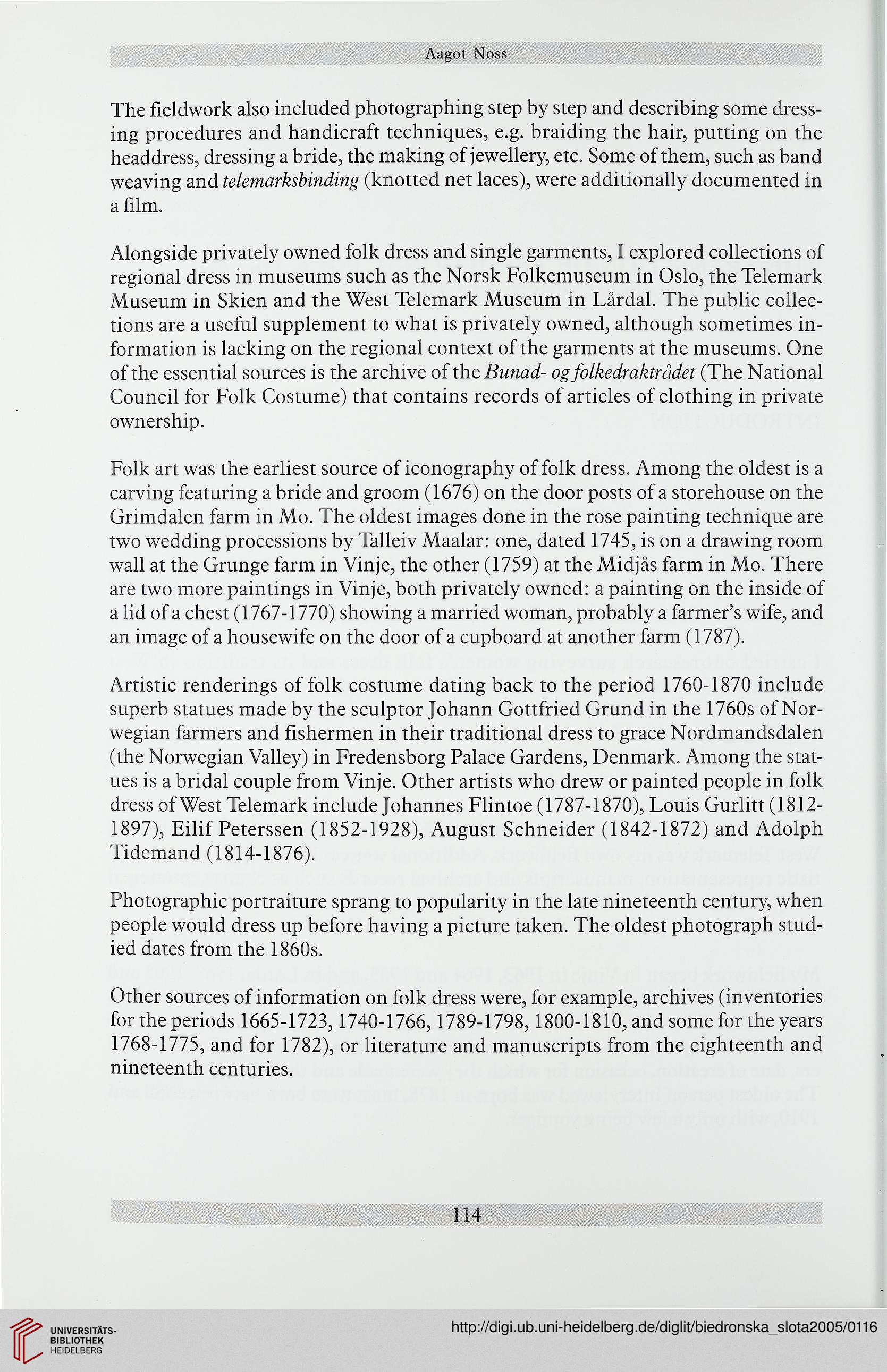Aagot Noss
The fieldwork also included photographing step by step and describing some dress-
ing procedures and handicraft techniąues, e.g. braiding the hair, putting on the
headdress, dressing a bride, the making of jewellery, etc. Some of them, such as band
weaving and telemarksbinding (knotted net laces), were additionally documented in
a film.
Alongside privately owned folk dress and single garments, I explored collections of
regional dress in museums such as the Norsk Folkemuseum in Oslo, the Telemark
Museum in Skien and the West Telemark Museum in Lardal. The public collec-
tions are a useful supplement to what is privately owned, although sometimes in-
formation is lacking on the regional context of the garments at the museums. One
of the essential sources is the archive of the Bunad- og folkedraktrddet (The National
Council for Folk Costume) that contains records of articles of clothing in private
ownership.
Folk art was the earliest source of iconography of folk dress. Among the oldest is a
carving featuring a bride and groom (1676) on the door posts of a storehouse on the
Grimdalen farm in Mo. The oldest images done in the rose painting techniąue are
two wedding processions by Talleiv Maalar: one, dated 1745, is on a drawing room
wali at the Grunge farm in Vinje, the other (1759) at the Midjas farm in Mo. There
are two more paintings in Vinje, both privately owned: a painting on the inside of
a lid of a chest (1767-1770) showing a married woman, probably a farmer's wife, and
an image of a housewife on the door of a cupboard at another farm (1787).
Artistic renderings of folk costume dating back to the period 1760-1870 include
superb statues made by the sculptor Johann Gottfried Grund in the 1760s of Nor-
wegian farmers and fishermen in their traditional dress to grace Nordmandsdalen
(the Norwegian Valley) in Fredensborg Palące Gardens, Denmark. Among the stat-
ues is a bridal couple from Vinje. Other artists who drew or painted people in folk
dress of West Telemark include Johannes Flintoe (1787-1870), Louis Gurlitt (1812-
1897), Eilif Peterssen (1852-1928), August Schneider (1842-1872) and Adolph
Tidemand (1814-1876).
Photographic portraiture sprang to popularity in the late nineteenth century, when
people would dress up before having a picture taken. The oldest photograph stud-
ied dates from the 1860s.
Other sources of information on folk dress were, for example, archives (inventories
for the periods 1665-1723,1740-1766,1789-1798,1800-1810, and some for the years
1768-1775, and for 1782), or literaturę and manuscripts from the eighteenth and
nineteenth centuries.
The fieldwork also included photographing step by step and describing some dress-
ing procedures and handicraft techniąues, e.g. braiding the hair, putting on the
headdress, dressing a bride, the making of jewellery, etc. Some of them, such as band
weaving and telemarksbinding (knotted net laces), were additionally documented in
a film.
Alongside privately owned folk dress and single garments, I explored collections of
regional dress in museums such as the Norsk Folkemuseum in Oslo, the Telemark
Museum in Skien and the West Telemark Museum in Lardal. The public collec-
tions are a useful supplement to what is privately owned, although sometimes in-
formation is lacking on the regional context of the garments at the museums. One
of the essential sources is the archive of the Bunad- og folkedraktrddet (The National
Council for Folk Costume) that contains records of articles of clothing in private
ownership.
Folk art was the earliest source of iconography of folk dress. Among the oldest is a
carving featuring a bride and groom (1676) on the door posts of a storehouse on the
Grimdalen farm in Mo. The oldest images done in the rose painting techniąue are
two wedding processions by Talleiv Maalar: one, dated 1745, is on a drawing room
wali at the Grunge farm in Vinje, the other (1759) at the Midjas farm in Mo. There
are two more paintings in Vinje, both privately owned: a painting on the inside of
a lid of a chest (1767-1770) showing a married woman, probably a farmer's wife, and
an image of a housewife on the door of a cupboard at another farm (1787).
Artistic renderings of folk costume dating back to the period 1760-1870 include
superb statues made by the sculptor Johann Gottfried Grund in the 1760s of Nor-
wegian farmers and fishermen in their traditional dress to grace Nordmandsdalen
(the Norwegian Valley) in Fredensborg Palące Gardens, Denmark. Among the stat-
ues is a bridal couple from Vinje. Other artists who drew or painted people in folk
dress of West Telemark include Johannes Flintoe (1787-1870), Louis Gurlitt (1812-
1897), Eilif Peterssen (1852-1928), August Schneider (1842-1872) and Adolph
Tidemand (1814-1876).
Photographic portraiture sprang to popularity in the late nineteenth century, when
people would dress up before having a picture taken. The oldest photograph stud-
ied dates from the 1860s.
Other sources of information on folk dress were, for example, archives (inventories
for the periods 1665-1723,1740-1766,1789-1798,1800-1810, and some for the years
1768-1775, and for 1782), or literaturę and manuscripts from the eighteenth and
nineteenth centuries.





